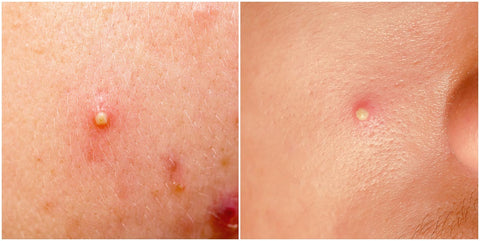
It could be a few tiny blackheads around the nose or a full-on cystic breakout, but acne affects 80% of Americans at some point in their lives. Whether your pimples are caused (or aggravated) by hormones, hygiene, environmental factors or genetics, the best first step in treating them is knowing exactly which type of acne you have. That’s why we’ve put together this handy guide to help you identify each type of pimple and devise your plan of attack.
A visual dictionary: 6 types of pimples


Whiteheads
What you see: Also known as closed comedones, whiteheads are pimples covered with a thin layer of skin – so they look like a small, white bump. They form when dead skin cells and oils collect within and clog pores.
What you can do about it: For starters, keep your hands away from your face. Unlike pustules (see below), whiteheads are under the skin and squeezing will not help. You’ll just end up with a pimple that’s even more irritated and inflamed. Try products that contain a combination of Salicylic, Lactic and Azelaic Acid (like Pimple Correct), which can help break down dead skin cells, sebum and other pore-clogging gunk.
RELATED READ: Blind Pimples: What They Are and How to Get Rid of Them

Blackheads
What you see: Also known as open comedones, blackheads look like dark, tiny dots. Like a whitehead, they are pores that have been clogged by dead skin cells and oils. However, there is no skin covering the pore, so the oil turns black from exposure to air. They typically first emerge during the teenage years and are often located on and around the nose.
What you can do about it: Again, don’t attempt blackhead removal by squeezing! We also don’t recommend old school pore strips because they remove the natural oils and hair follicles that healthy skin needs. Instead, try Pore Release, a powerful, derm-tested treatment that reduces blackheads in just 3 uses*.

Papules
What you see: Patches of tender, small, pink or red bumps without a head. These bad boys pop up when a pore’s follicular wall breaks down and the white blood cells come into contact with C. acnes bacteria.
What you can do about it: Picking papules is a no-no, as it will cause scarring. You should also avoid skin irritants, excessive exfoliation, and oil-based cosmetics or sunscreen. A daily routine that balances oil, exfoliates, and hydrates (like Clear Collective) can help keep skin clear and a sunscreen that's designed for acne-prone skin won’t clog pores.

Pustules
What you see: Close your eyes and picture a pimple. You probably imagined a pustule, a bulging patch of skin filled with white or yellow pus. They may look like bigger, more “poppable” whiteheads. The gunk inside is the result of excess oil and dead skin cells clogging pores, coming into contact with bacteria, and triggering an inflammatory response by the immune system.
What you can do about it: Use a cleanser that helps unclog pores, dry your skin and stick on a Mighty Patch Original or Invisible+, which will absorb pus and gunk from the pimple. If you simply cannot resist the urge to pop, make sure you are following the five basic rules for clean, safe pimple popping and use Rescue Balm to soothe the area.

Cystic acne
What you see: Large (sometimes giant), red and painful pimples underneath your skin. Cysts appear when bacteria, oil and dead skin cells build up deep within pores, causing an infection. One of the more severe types of acne, it can linger for years, affect large areas, and leave skin sore and with permanent scars.
What you can do about it: To help with the pain and inflammation, apply an ice cube directly to the breakout for a few seconds, which will constrict the small blood vessels feeding the cysts. If your cystic acne is recurring, you may want to visit a dermatologist, who can treat the breakouts with cortisone injections, oral medications or prescription topical formulas.

Nodules
What you see: Sometimes confused with cysts, nodules are large, painful bumps deep under the skin that can be skin-toned or red from inflammation. While cysts are filled with pus that makes them softer, nodular acne is hard to the touch and often more difficult to treat. They occur when C. acnes bacteria, sebum and dead skin cells get trapped in pores. It can take weeks to months for a nodule to come to a head.
What you can do about it: Topicals and OTC products typically don’t help, since nodules lie deep within the skin. Derms recommend prescription treatments to thoroughly treat nodular acne. If nodular breakouts are a frequent occurrence, visit your derm for in-office LED treatments and/or oral medications.
And to help keep skin and pores clear before nodules or other pimples emerge, regularly use skincare products that contain Salicylic Acid.
*Based on self-assessments in a 14-day clinical trial












.png?v=1663017252122)






